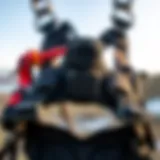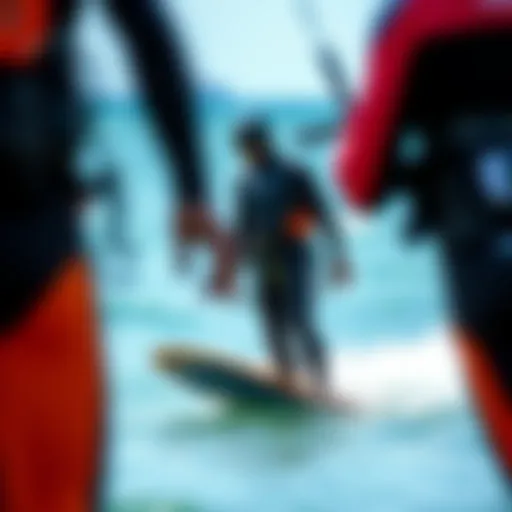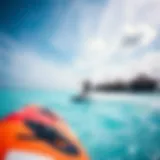Essential Guide to Buying Used Kite Gear
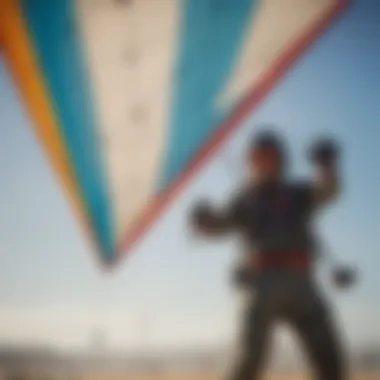

Intro
Navigating the world of kiteboarding does require a fair bit of know-how, especially when it comes to selecting used gear. It's not just about tossing down some cash on a kite and waving it in the air; one has to consider several factors to ensure a worthwhile purchase. When the right equipment comes into play, the joys of riding the winds can be extraordinary. However, making the wrong choice could lead to a frustrating experience on the water.
This guide is structured to help kiteboarding enthusiasts—whether you're a novice or a seasoned kite pro—grasp the essential aspects associated with buying used equipment. We'll cover everything from crucial components, vital maintenance tips, where to find high-quality gear, and how to assess its condition. Knowledge is power, after all, and having the right information can make a significant difference in your kiteboarding journey.
Stay tuned as we explore these topics to empower you in your gear acquisition process.
The Appeal of Used Kite Gear
When it comes to kiteboarding, the allure of used gear can hardly be overstated. As enthusiasts of the sport, we often find ourselves navigating a world filled with branded equipment, flashy designs, and modern advancements. But what about diving into the realm of pre-owned gear? The appeal of used kite gear stands as a compelling option for both seasoned riders and newcomers alike. This decision isn't merely about frugality; it touches on various facets that demand careful consideration. Let's break down the vital elements that make this path enticing.
Cost Savings
First and foremost, the financial advantages associated with used kite gear cannot be ignored. Kiteboarding is a thrilling sport, yes, but it can also run up quite the bill. New kites, boards, and harnesses can make a dent in your wallet faster than you can say ‘air bag.’ By opting for second-hand equipment, kiteboarders can enjoy significant cost savings.
Imagine picking up a high-quality used kite for a fraction of the price. This gives you, the kiteboarder, a greater opportunity to experiment with different styles, sizes, and brands that you normally wouldn’t consider when shopping new. For instance, instead of committing to a brand-new North Kiteboarding that costs a pretty penny, you might find a barely-used model from a fellow kite junkie ready to sell at a much more reasonable price.
While one may think that cheaper equates to inferior quality, that is not always the case. Many sellers take great care of their gear, storing it properly and using it sparingly. Plus, many experienced kiteboarders upgrade their equipment frequently, leading to excellent condition used gear on the market.
Here are a few tips to leverage the savings:
- Shop smart: Look for seasonal sales or community swaps.
- Negotiate: Many sellers are open to reasonable offers.
- Bundle deals: Sometimes purchasing a complete set can help you land a better price.
Environmental Considerations
In today’s world, there’s a mounting emphasis on environmental consciousness. Kiteboarding enthusiasts often share a love for the outdoors, and understanding the environmental implications of our purchases adds another layer to the appeal of used gear. By purchasing pre-owned items, you intentionally participate in reducing waste and minimizing your carbon footprint.
The kite industry, like many others, generates quite a bit of waste. Manufacturing new gear requires raw materials and energy, contributing to pollution and resource depletion. Each time you buy used, you’re effectively extending the life of a product that might otherwise find its way into a landfill. This conscious decision resonates with environmentally-aware kiteboarders who wish to enjoy their sport without compromising their values.
Moreover, buying used can foster a sense of community. When kiteboarders trade or sell gear, it connects individuals, creating opportunities for conversation and shared experiences. You might pick up a second-hand board but also enrich your knowledge by chatting with the seller about their ride experience or even the local spots where the best winds can be found.
To make environmental advocacy a core part of your kiteboarding experience, consider:
- Joining local exchange programs: Many regions host events to swap gear among kiteboarders.
- Supporting eco-conscious brands: Look for companies that prioritize sustainability in their manufacturing processes.
"The true beauty of kiteboarding lies not just in the winds we catch, but also in the community we create and the planet we cherish."
In summary, the appeal of used kite gear unfolds through multiple dimensions. Financial savings provide a practical motivation, while environmental considerations appeal to our innate desire to protect the planet. As kiteboarding grows in popularity, understanding these factors can shape a more responsible and enriching experience.
The Risks Involved
When purchasing used kite gear, it’s crucial to understand the potential risks involved. The thrill of kiteboarding shouldn’t be overshadowed by worries about your equipment failing or compromising your safety. This section dives into two significant concerns: compromised safety and performance limitations. Recognizing these risks helps you make informed choices that can safeguard your experience on the water.
Compromised Safety
Safety comes first in the world of kiteboarding. Using second-hand gear can sometimes lead to safety issues that are easily overlooked. For instance, a kite may have micro-tears that aren’t visible unless you examine it closely. What might seem like a good deal can quickly turn into a dangerous situation if the kite fails mid-flight.
- Inspect for Damage: Always do a thorough visual inspection of the kite and the lines. Look for signs of wear and tear, fraying, or fading. Sun exposure can degrade materials, making them less reliable.
- Check the Control Bar and Lines: The control bar is your connection to the kite, and damaged lines can snap. Make sure to look for any cracks, rust, or fraying. The last thing you want is to be caught off guard when you're high in the air.
Compromised safety isn’t just about equipment condition. It also involves understanding how well the gear suits your skill level. Gear that’s too advanced or not appropriate for your weight or skill might lead to accidents. It’s essential to match your equipment with your ability.
Performance Limitations
Another risk to keep in mind is performance limitations that used kite gear may present. Over time, even high-quality gear can lose its edge. A kite that once handled beautifully might start to show signs of age that affect how it reacts to wind or the rider’s inputs.
- Outdated Technology: Kiteboarding has seen several advancements in technology and design. If you’re buying older gear, be aware that it may lack modern features such as improved materials, better stability, or enhanced responsiveness.
- Personal Preference: What works for one person may not work for another. Sometimes, the performance limitations are more about individual comfort and control rather than the gear itself. Testing a second-hand kite might feel different compared to a brand new one, especially if the design philosophy has evolved.
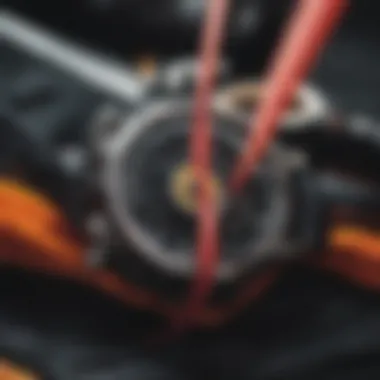

These performance aspects can affect your enjoyment and ability on the water, which is why it’s essential to test the gear—if you can—before finalizing your purchase.
"The right gear can make a good day on the water a great one, but the wrong gear? It can feel like a wolf in sheep’s clothing."
Key Components of Kite Gear
When it comes to kiteboarding, understanding the key components of kite gear is crucial. Each element plays a vital role in delivering performance, safety, and enjoyment while riding the waves. The various parts of the gear, such as kites, boards, control systems, and harnesses, must work in harmony for an optimal experience. Diving into each component will not only help you appreciate the engineering behind them, but also assist in making informed decisions when buying used gear.
Kites
Types of Kites
Choosing the right type of kite can make or break your experience on the water. There are a few prominent broad categories here: inflatable kites and foil kites. Inflatable kites, which are probably the most popular among riders, feature air-filled bladders that provide structure and stability. On the other hand, foil kites do not rely on air bladders, and instead, are shaped like an aircraft wing. They tend to be lighter and can pack down smaller, making them a great pick if you're traveling.
Understanding Sizes and Shapes
Grasping the sizes and shapes of kites can significantly impact your riding experience. Kites come in various sizes typically categorized as small, medium, and large, each suited for different circumstances and riders' weights. The shape of the kite also affects how it performs in the air and how it reacts to wind.
For instance, a wider kite generates more power but can also be less responsive to steering inputs. In contrast, a narrower kite might provide agile handling at the expense of raw power. Therefore, understanding sizes and shapes is not just about picking one that looks good; it's a balance between your experience, preferred riding style, and prevailing wind conditions.
Boards
Material Choices
The material composition of a board can hugely influence its performance and durability. Common materials found in kiteboards include wood, fiberglass, carbon fiber, and plastic composites. Each of these comes with its own set of characteristics. For example, wood boards tend to be more buoyant and provide a softer ride, while carbon fiber boards are known for their stiffness and lightweight properties.
Choosing the right material can mean the difference between a smooth ride and a troublesome outing. A lightweight board is beneficial for jumping and tricks, while a sturdier board can withstand more punishment during rough conditions. Thus, understanding material choices when looking at used gear is vital for aligning your board with your riding style.
Board Shapes and Its Impact
Board shapes are another critical component that can affect performance. The overall shape—whether it's twin-tip, directional, or surf-style—comes down to personal preference and intended use. For example, twin-tip boards are versatile and suitable for most conditions, making them a common choice among new riders.
On the flip side, a surf-style board is designed for riders who prefer a more traditional surf experience on waves. The unique feature here is the rocker line, which impacts how the board sits in the water and how it rides. A more pronounced rocker can make it easier to ride on bigger waves, while a flatter board is better suited for speed and stability. Understanding board shapes allows you to better tailor your used board selection to suit your style and needs.
Control Systems
Lines and Bar Analysis
The control system of kite gear constitutes essential functionality, particularly the lines and bars. The control bar is what gives you the ability to steer the kite effectively. Generally, longer lines can enable deeper downwind capabilities but can make handling slightly trickier, especially for beginners.
Analyzing the line count is also important—most setups feature either a four-line or five-line configuration, with the latter providing added safety features. Understanding these nuances will ensure that you maintain control over your kite, enjoy your sessions safely, and maximize your fun on the water.
Safety Systems Explained
When it gets dicey out there, your safety system becomes paramount. Features like quick-release mechanisms are what can save your day—literally. Most modern control systems come equipped with an easy-to-access quick release. This characteristic allows you to disable the kite quickly in case of an emergency.
Understanding how safety systems work will help prevent accidents and give you more confidence on the water. A well-tested used safety system could mean the difference between a thrilling ride and a harrowing experience.
Harnesses
Types of Harnesses
Harnesses come in various styles—seat, waist, and hybrid, defining how they distribute loads and provide support. Seat harnesses have lower back coverage and distribute pressure evenly, making them a fine choice for those who prioritize comfort over mobility. Then there's the waist harness, which sits higher and allows for more freedom of motion; this is a popular choice among more seasoned riders who need that edge in maneuverability.
Understanding the types of harnesses available will help you pick one that matches your riding style and comfort levels, especially when seeking out used gear.
Choosing the Right Fit
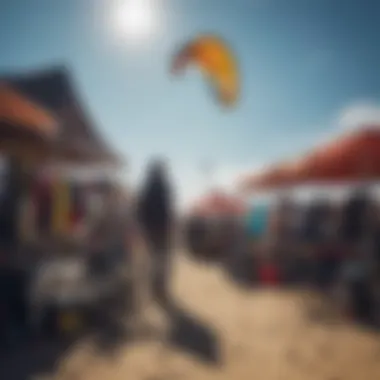

Fitting your harness correctly can significantly elevate your kiteboarding experience. Pay close attention to both size and style. An ill-fitting harness could lead to chafing or discomfort, which is the last thing anyone wants while trying to enjoy the ride.
Moreover, a snug harness provides better support and transfer of energy from the kite to the board. Your harness should feel like a natural extension of you, promoting freedom of movement while maximally supporting your body. Thus, ensuring you choose the right fit is imperative when evaluating used gear.
Assessing Second-Hand Gear
When it comes to second-hand kite gear, assessing its condition is crucial. This stage can make the difference between a thrilling ride on the water and a regrettable encounter with equipment failure. A comprehensive assessment not only saves you money but also ensures your safety, thus enhancing your overall kiting experience. It’s more than just knowing what you’re buying; it's about understanding its backstory and how well it’s been taken care of.
Visual Inspection
Visual inspection is where it all begins. Before anything else, you should take a long, hard look at the gear. Keep an eye out for any signs of wear and tear, discoloration, or damage. Here’s what to consider as you undertake this crucial first step:
- Kites: Check the sail for rips or patches. Small punctures can turn into major problems when you’re in the air. The leading edge should be intact without any signs of delamination.
- Boards: Look closely at the bottom for scratches or gouges. A heavily damaged board can affect your performance and safety.
- Control Systems: Ensure that lines aren't frayed or stretched. They bear the brunt of the load while you’re kiting, so any compromise can lead directly to disaster.
- Harnesses: Inspect the straps and loops for any fraying. A harness in good condition holds you securely to your board, so its integrity is paramount.
Taking the time to examine these elements visually gives you a good baseline on whether the gear is worth pursuing further.
Functional Testing
After you’ve made your visual assessment, the next logical step is functional testing. This step involves checking how well the gear actually works under usage conditions.
- Kite Flexibility: Inflate the kite and look how it maintains its shape. Any sagging could signal fatigue in materials.
- Board Performance: Take the board for a short, safe run if possible. Pay attention to how it ride—are there any unexpected vibrations or is it unstable?
- Control System Responsiveness: Fly the kite, if feasible. Test the responsiveness of the lines and ease of control. Make sure everything functions smoothly.
Tip: When testing the gear, do so in a safe, controlled environment. The last thing you want is to find a fault while you’re out at sea.
Researching Brand Reputation
The quality of the brand can often outweigh wear and tear when buying used gear. Some brands are well-known for durability, while others might be notorious for yielding subpar products. Researching brand reputation should be part of your assessment strategy. Consider these points:
- Online Reviews: Platforms like Reddit and specialized forums can offer a treasure trove of info. Look for discussions on durability and performance.
- Historical Performance: Some brands have decades-long track records, while new entrants may not yet have proven themselves.
- Community Feedback: Ask fellow kiteboarders about their experiences with the gear. Personal anecdotes can provide insight you won’t find in user manuals or advertisements.
Understanding the brand’s background helps put any wear into context. A minor tear in gear from a reputable brand may not affect performance in the same way that a similar issue would with a less-known brand.
Where to Find Quality Used Gear
Finding the right place to buy used kite gear is as crucial as choosing the gear itself. Each location has its unique set of offerings, advantages, and mere pitfalls. Grabbing a good deal isn't just about price; it's about quality, reliability, and ensuring your safety on the water. This section will explore various avenues available for kiteboarders eager to snag some second-hand gear.
Online Marketplaces
The digital world is teeming with opportunities if you're looking for used kite gear. Websites such as eBay, Craigslist, and specialized sports resale platforms like Kitesurfing.com are treasure troves for budget-conscious kiteboarders. Here’s why you might want to explore these options:
- Abundant Selection: The sheer volume of listings means you're likely to find what you're after, whether it’s a well-loved kite or a used board.
- Price Flexibility: With various sellers, you can often find bargains, but do keep an eye out for inflated prices.
- User Reviews: Many online platforms allow feedback from previous buyers, helping you gauge the reliability of the seller and the quality of the gear.
However, do approach online shopping with caution. A picture might say a thousand words, but it doesn’t always tell the entire story. Asking for detailed photos and clarifications about the condition of the gear is prudent before making a commitment.
Local Kiteboarding Shops
While the internet is a great resource, local kiteboarding shops offer a slice of the personal touch often missing from online marketplaces. They can be a goldmine for finding quality used gear. Here are some key considerations when visiting these shops:
- Expert Advice: Store employees often have firsthand experience with the gear, allowing for tailored recommendations based on your skill level and preferences.
- Physical Inspection: Being able to examine the gear in person is invaluable. You get to check the condition, feel the harness, and inspect the seams of a kite, something you cannot do online.
- Return Policies: Many local shops offer return policies, allowing you to exchange gear if it doesn’t meet your expectations after purchasing.
Local shops sometimes host trade-ins, where you can score equipment at reasonable prices while also selling your unwanted gear. It’s a win-win!
Kiteboarding Community Forums
The kiteboarding community is vibrant and resourceful, and participating in forums can lead you to amazing finds. Platforms such as Reddit and dedicated kiteboarding forums are excellent places to exchange knowledge and make purchases.
- Genuine Recommendations: Fellow enthusiasts often share their experiences and can point you toward trustworthy sellers.
- Tailored Offers: Usually, community members are aware of each other's gear and needs, creating an atmosphere ripe for bargaining.
- Safety in Numbers: Being part of a community helps in verifying the quality of the second-hand gear you might consider purchasing.
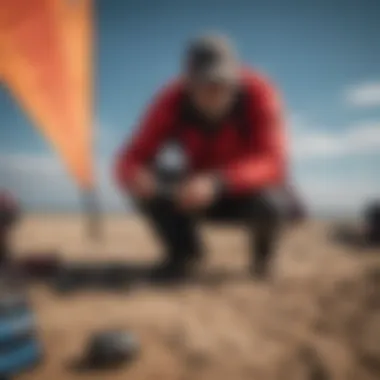

Don't underestimate the power of networking; establishing relationships with local kiteboarders can also pave the way to discovering used gear before it’s even listed publicly.
"Connecting with your local community can sometimes lead to the best deals that may not even hit the market."
Finding quality used kite gear takes effort and some savvy research across various platforms. By utilizing online marketplaces, local shops, and community forums, you can enhance your chances of landing solid gear that lets you ride the waves without breaking the bank.
Maintenance Tips for Used Gear
Taking care of used kite gear is crucial for maintaining safety, performance, and longevity. Used equipment can sometimes harbor hidden issues that, if left unchecked, could lead to accidents or diminished performance on the water. Therefore, ensuring that the gear is regularly maintained not only extends its life but also enhances the overall kiteboarding experience. This section delves into three primary aspects of gear maintenance: cleaning and storage, routine inspections, and repair techniques.
Cleaning and Storage
Keeping your kite gear clean is more than just a cosmetic chore. Saltwater, sand, and dirt can damage the materials and components of your equipment over time. A good practice is to rinse your gear with fresh water after each session. This simple act helps wash away corrosive salt and grime that can wear down fabric and hardware.
Storage is equally important. Storing gear in a cool, dry place minimizes the risk of mold and mildew forming, particularly on harnesses and kites. Consider using breathable storage bags rather than plastic ones, which can trap moisture. When possible, store kites inflated to maintain their shape but avoid folding them sharply, as that can create creases over time. Here are a few quick cleaning tips:
- Always rinse the lines and bar with freshwater after every use.
- Use a mild soap and a soft brush for cleaning the kite's fabric.
- Hang the harness to dry instead of folding it up damp.
"A stitch in time saves nine." – This old saying rings true in kite maintenance. Proper attention today can save you costly repairs tomorrow.
Routine Inspections
Before hitting the waves, conduct routine inspections to identify any potential issues. This includes checking the lines for fraying and the kite for any punctures or leaks. Even tiny tears can lead to a much larger problem if not addressed. Here's a checklist for a thorough inspection:
- Kite fabric: Look for rips or worn areas, particularly around the seams and leading edge.
- Lines and bar: Ensure that there are no tangles or wear. Inspect for fraying where the lines connect to the kite.
- Harness: Make sure the buckle mechanisms work and that there are no cracks or signs of wear in the material.
By keeping an eye on these details, you can spot potential problems before they escalate, ensuring a safer ride every time you go out.
Repair Techniques
Even with meticulous maintenance, wear and tear is a reality in kiteboarding. Knowing a few repair techniques can save you money and extend the life of your gear. If you notice small tears or punctures in your kite, a repair kit is invaluable. Most kits come with adhesive patches specifically designed for kite materials. Here's how you can approach repairs:
- Identify the damage: Pinpoint the location and size of the tear or hole.
- Prepare the surface: Clean the area around the damage thoroughly; this helps ensure a good seal for the patch.
- Apply the patch: Follow the instructions provided with your repair kit. Make sure to apply pressure to bond the patch securely.
Additionally, learning to replace lines yourself can be a handy skill. There are plenty of tutorials available on platforms like Reddit.com or Facebook.com that provide insights into line replacement and other detailed repair techniques.
By taking these maintenance tips seriously, kiteboarders can enjoy their used gear for many seasons while ensuring safety and performance on every ride.
Closures on Used Kite Gear
In the ever-evolving world of kiteboarding, navigating the waters of used kite gear requires both careful consideration and a critical eye. Concluding the journey through this complex segment sheds light on the balanced view of making purchases. Understanding used kite gear isn't just about savings or trends; it encompasses safety, performance, and long-term investment. This section aims to distill the knowledge acquired throughout the guide, emphasizing that while opportunities abound in the realm of second-hand equipment, so too do potential pitfalls.
Weighing the Pros and Cons
When it comes to purchasing used gear, it's vital to weigh the benefits against the drawbacks.
Pros:
- Cost Efficiency: One of the biggest draws of buying pre-owned kite gear is the potential for significant savings. High-quality equipment can often be found at a fraction of the original price, allowing newcomers to enter the sport or experienced enthusiasts to expand their collection without maxing out their budgets.
- Environmental Impact: Embracing second-hand gear can contribute to reducing waste. Reusing equipment minimizes your carbon footprint, promoting a more sustainable approach to leisure activities.
- Unique Finds: The second-hand market often features discontinued or hard-to-find models that aren't easily accessible in retail stores. Some kiteboarders thrive on discovering a gem that others might overlook.
Cons:
- Safety Concerns: Older equipment carries the risk of wear and tear that can compromise safety. It’s crucial to have a thorough understanding of what constitutes safe equipment.
- Unpredictable Performance: Not all used gear performs to the same standard as new. Deterioration over time can affect responsiveness, durability, and overall experience on the water.
- Lack of Warranty: Most second-hand purchases come without any guarantee, leaving buyers at risk if something goes wrong shortly after purchase.
"Being savvy about what to look for in used gear can be your lifeline between enjoying your ride and risking your safety."
In reflecting on these points, it’s clear that while buying used equipment can be enticing, due diligence is non-negotiable.
Making Informed Purchases
Informed decision-making is the bedrock of a satisfactory purchase experience in the second-hand kite gear market. Without a proper strategy, kiteboarders can easily find themselves at the mercy of tricky sellers and subpar products. Here are critical considerations to ensure wise investments:
- Research: Knowledge is power. Familiarize yourself with specific brands, models, and typical price ranges for used gear. Reviews from other kiteboarders can offer invaluable insight into what to expect.
- Inspect Thoroughly: Before making a purchase, don’t be shy about physically inspecting the gear. Check for signs of degradation, rips, or unusual wear patterns. If it’s not possible to inspect in person, ask for high-resolution photos and detailed descriptions from sellers.
- Test If Possible: Whenever feasible, arrange to actually experience the gear before committing. Some local shops offer rentals or demo days for second-hand gear. Testing it out gives firsthand knowledge of how it performs.
- Connect with the Community: Utilize online platforms such as Reddit or Facebook to engage with experienced kiteboarders. Discussions in kiteboarding communities are often rich with tips on navigating the used gear market.
